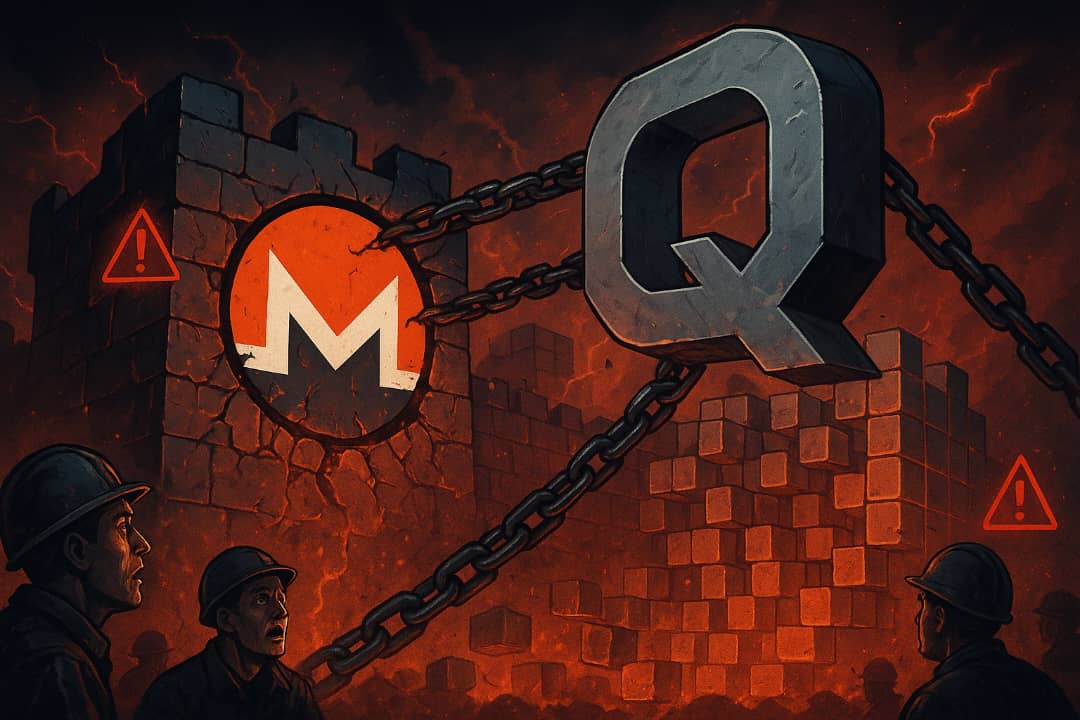Monero network is in crisis. The mining pool Qubic now controls the majority of its hash rate, enabling a large-scale blockchain reorganization.
The alarm was raised by @evilcos, founder of SlowMist. He warned that Qubic’s dominance allows it to rewrite the blockchain’s history, launch double-spend attacks, and censor transactions.
Ledger’s CTO estimates maintaining such control costs around $75 million per day. For context, that’s more than the GDP of some small nations, burned daily just to keep the grip on Monero’s blocks. Experts say this level of dominance is a direct, existential threat to the network’s security.
What Happened With Monero
Monero, the privacy-focused blockchain launched in 2014, has been a target for governments and three-letter agencies for years. It’s banned from most major centralized exchanges.
Qubic’s move wasn’t sudden. The pool has been amassing hash power for months. This morning, the inevitable happened, a major chain reorganization was detected.
With current control, Qubic can:
- Rewrite the blockchain at will.
- Double-spend coins.
- Censor any transaction it chooses.
The economics are chilling. Sustaining the attack may be profitable in the short term, but it risks shattering confidence in Monero overnight. Competing miners now face a bleak choice: keep mining blocks Qubic can discard, or walk away. With the ability to orphan any competing block, Qubic is effectively the sole miner.
David vs. Goliath, But in Reverse
In raw market cap terms, this is a smaller chain swallowing a bigger one.
Qubic (QUBIC): ~$300M market cap.
Monero (XMR): ~$6B market cap, price down 13% since the attack.
The imbalance is striking. A $300M protocol now has the technical upper hand on a chain twenty times its size.
Possible Options for Monero
Monero’s recovery path is narrow. A hard fork to change the proof-of-work algorithm is possible but would require rapid coordination and community trust. Exchanges could halt deposits and withdrawals, isolating the network until the threat passes. Miners could attempt to reclaim hash power, but outbidding an actor burning $75M per day is a steep hill.
The longer Qubic maintains control, the more damage is done to Monero’s credibility. If miners quit and transactions stall, XMR’s liquidity and adoption could collapse.
Why This Matters
Majority hash control is the nightmare scenario for proof-of-work chains. It undermines the “immutable” promise of blockchain, opening the door to fraud and censorship. For Monero, a project whose identity is built on privacy and uncensorable transactions, this is a direct hit to its core value proposition.
Qubic’s public stance remains unclear. Some speculate the move could be framed as a “stress test” or a “defensive measure” against worse actors. Others see it plainly: a hostile takeover.
The Market Reacts
So far, the price drop has been sharp but not catastrophic, down 13%. That could change fast if exchanges react, or if word spreads beyond crypto circles. If traders believe the network’s integrity is gone, the sell-off could accelerate.
For now, all eyes are on the Monero developer community, exchange operators, and miners. This is an arms race measured in petahashes and dollars burned per day.
Bottom line: Monero has faced scrutiny before, but never a direct takeover of its mining power. If Qubic holds the line at $75M a day, the privacy giant may soon be in the hands of a much smaller rival, proof that in crypto, hash power can matter more than market cap.
Disclosure: This is not trading or investment advice. Always do your research before buying any cryptocurrency or investing in any services.
Follow us on Twitter @themerklehash to stay updated with the latest Crypto, NFT, AI, Cybersecurity, and Metaverse news!

